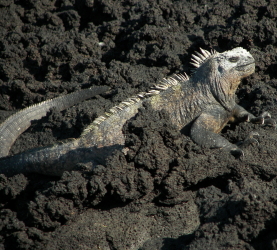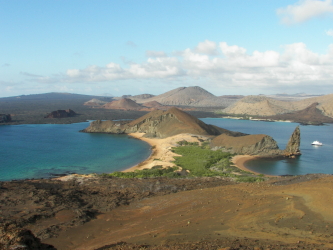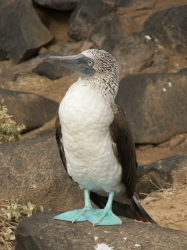|
The following is a list of the islands we visited in the Galapagos
with a brief description of each. If you click on an island name,
you will go to a page with more detailed descriptions of our activities
on that island and photos of the scenery and animals/birds we saw.
For additional photos and information about specific animals or
birds, please go to the Photo Gallery.
North Seymour Island
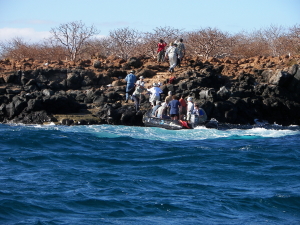 On
North Seymour Island, it was all ashore for our first hike. This
was a dry landing from the zodiaks (aka pangas), on to black basaltic
lava. Each group of 12 was accompanied by a naturalist who explained
how important it was to stay on the marked trails so as not to disturb
the breeding areas of the birds and animals on the islands. We saw
the colorful Frigatebird, illusive Land Iguana and Sea Lions galore. On
North Seymour Island, it was all ashore for our first hike. This
was a dry landing from the zodiaks (aka pangas), on to black basaltic
lava. Each group of 12 was accompanied by a naturalist who explained
how important it was to stay on the marked trails so as not to disturb
the breeding areas of the birds and animals on the islands. We saw
the colorful Frigatebird, illusive Land Iguana and Sea Lions galore.
Espanola Island
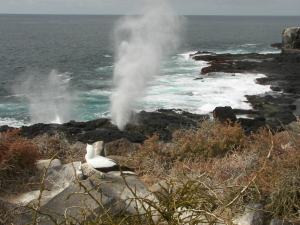 Fred
took the early (5:15) wake up call to go with the photographers
to Punta Suarez on Espanola Island. Barb slept in till 6 for a leisurely
breakfast before the 8 am excursion to the same area. This southern
most island has extensive nesting sites of seabirds, plus dramatic
cliff scenery and a blowhole. The 2 hour hike started off cool,
but by the end we were rolling up our sleeves and unzipping our
pant legs. We saw both masked and blue footed boobies doing their
mating dance, the waved albatross and their babies, colorful lava
lizards and the marine iguana which is unique to the Galapagos. Fred
took the early (5:15) wake up call to go with the photographers
to Punta Suarez on Espanola Island. Barb slept in till 6 for a leisurely
breakfast before the 8 am excursion to the same area. This southern
most island has extensive nesting sites of seabirds, plus dramatic
cliff scenery and a blowhole. The 2 hour hike started off cool,
but by the end we were rolling up our sleeves and unzipping our
pant legs. We saw both masked and blue footed boobies doing their
mating dance, the waved albatross and their babies, colorful lava
lizards and the marine iguana which is unique to the Galapagos.
Floreana Island
 Floreana
was the first island to be inhabited by humans. Today there are
only a handful of inhabitants. One of the most famous spots on the
island is Post Office Bay. In 1793, British navigators placed a
large wooden barrel here to leave messages and mail for homebound
voyagers. The tradition has continued until the present day. Visitors
can leave postcards to be picked up and hand delivered later by
other visitors from their destination town. Visiting yachts have
added their calling cards, pieces of carved driftwood. We visited
a lagoon with Pink Flamingos and a beach crawling with colorful
Sally Lightfoot Crabs. Floreana
was the first island to be inhabited by humans. Today there are
only a handful of inhabitants. One of the most famous spots on the
island is Post Office Bay. In 1793, British navigators placed a
large wooden barrel here to leave messages and mail for homebound
voyagers. The tradition has continued until the present day. Visitors
can leave postcards to be picked up and hand delivered later by
other visitors from their destination town. Visiting yachts have
added their calling cards, pieces of carved driftwood. We visited
a lagoon with Pink Flamingos and a beach crawling with colorful
Sally Lightfoot Crabs.
Isabela Island
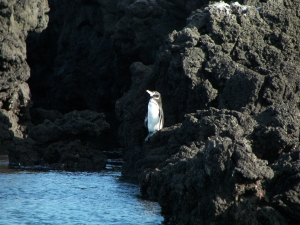 Had
a wake-up call for 6:15 to view the ship going around Roca Redonda
- a huge rock outcropping in the middle of the ocean. It is the
top of an extinct volcano and the feeding site for hundreds of seabirds.
Bottle-nose dolphins played in our bow wake. After breakfast we
crossed the equator. Then we got into zodiaks for a ride around
Volcan Ecuador on Isabela Island. Isabela Island is the largest
island in the Galapagos and has 5 of the biggest volcanos. Volcan
Equador is one of the most impressive as it was sliced in half by
wave action. This was our first sighting of the Galapgos Penguin
- the only Penguin found in the northern hemisphere. Had
a wake-up call for 6:15 to view the ship going around Roca Redonda
- a huge rock outcropping in the middle of the ocean. It is the
top of an extinct volcano and the feeding site for hundreds of seabirds.
Bottle-nose dolphins played in our bow wake. After breakfast we
crossed the equator. Then we got into zodiaks for a ride around
Volcan Ecuador on Isabela Island. Isabela Island is the largest
island in the Galapagos and has 5 of the biggest volcanos. Volcan
Equador is one of the most impressive as it was sliced in half by
wave action. This was our first sighting of the Galapgos Penguin
- the only Penguin found in the northern hemisphere.
Fernandina Island
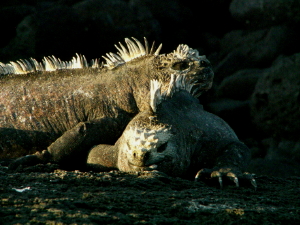 Our
afternoon excursion was to Fernandina Island. This is the westernmost
island and one of the youngest ones. It is also the most volcanically
active island in the world. The last eruption was in May, 2005.
Much of the island is composed of new lava with no vegetation. It
is probably the world's largest pristine island, that is, all the
plants and creatures arrived here naturally or evolved in place.
There is a huge colony of marine iguanas on the island. Hundreds
of them are piled on lava rock. Since they blended into the lava,
we had to be careful not to step on them as we walked around. Our
afternoon excursion was to Fernandina Island. This is the westernmost
island and one of the youngest ones. It is also the most volcanically
active island in the world. The last eruption was in May, 2005.
Much of the island is composed of new lava with no vegetation. It
is probably the world's largest pristine island, that is, all the
plants and creatures arrived here naturally or evolved in place.
There is a huge colony of marine iguanas on the island. Hundreds
of them are piled on lava rock. Since they blended into the lava,
we had to be careful not to step on them as we walked around.
Santa Cruz Island
 Santa
Cruz has the largest population of the five inhabited islands of
the Galapagos. The town of Puerto Ayora has 15,000 residents and
is home to the national park headquarters and the Charles Darwin
Research Center. Though primarily an international scientific research
station, it is one of the most visited spots on the islands. There
is a tortoise raising center in an effort to replace the population
of tortoises that were destroyed during the whaling days. Tortoise
eggs are retrieved and tagged with the island they were from. At
5 years old, the tortoises are released back on the same island.
The temperature of the eggs determines the sex of the tortoise,
females require warmer incubation. The most famous occupant in the
research center is Lonesome George. He is the last tortoise of his
species from Pinta Island and researchers are trying to get him
to breed with females of a sub-species close to his. But so far,
nothing has worked. At over 80 years old, he just doesn't seem to
be interested! Santa
Cruz has the largest population of the five inhabited islands of
the Galapagos. The town of Puerto Ayora has 15,000 residents and
is home to the national park headquarters and the Charles Darwin
Research Center. Though primarily an international scientific research
station, it is one of the most visited spots on the islands. There
is a tortoise raising center in an effort to replace the population
of tortoises that were destroyed during the whaling days. Tortoise
eggs are retrieved and tagged with the island they were from. At
5 years old, the tortoises are released back on the same island.
The temperature of the eggs determines the sex of the tortoise,
females require warmer incubation. The most famous occupant in the
research center is Lonesome George. He is the last tortoise of his
species from Pinta Island and researchers are trying to get him
to breed with females of a sub-species close to his. But so far,
nothing has worked. At over 80 years old, he just doesn't seem to
be interested!
Bartolome Island
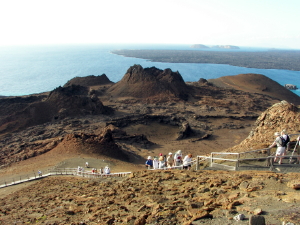 The
panoramic view from the summit of Bartolome is one of the most photographed
landscapes on the islands.We had a 6am wake-up call for the walk
to the top as it gets quite warm later in the day. Park Rangers
have built wooden steps up to the summit to prevent erosion - 372
stairs to be exact. The volcanic moonscape of rust colored spatter
cones contrasts with the large pale tuff cones and sooty lava flows.
Few plant species can withstand the drought conditions that occur
here. But the landscape did have some interesting plants including
the lava cactus and the tiquilia shrub which are food for the lava
lizards. The
panoramic view from the summit of Bartolome is one of the most photographed
landscapes on the islands.We had a 6am wake-up call for the walk
to the top as it gets quite warm later in the day. Park Rangers
have built wooden steps up to the summit to prevent erosion - 372
stairs to be exact. The volcanic moonscape of rust colored spatter
cones contrasts with the large pale tuff cones and sooty lava flows.
Few plant species can withstand the drought conditions that occur
here. But the landscape did have some interesting plants including
the lava cactus and the tiquilia shrub which are food for the lava
lizards.
Santiago Island
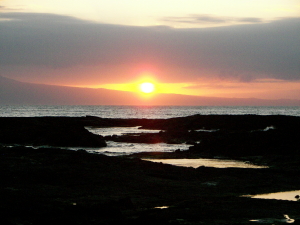 On
a snorkeling trip in the afternoon off Puerto Egas on the western
end of Santiago Island proved quite an adventure. Barb was swimming
back to the beach when a booby bird was attacked by a frigatebird,
causing the booby to drop their newly caught fish. It dropped into
the water right in front of her and immediately four pelicans swooped
in to grab it. Barb ducked under the water to keep from being hit.
Our later walk on the beach was one of the best of the trip. We
finally found some fur seals sleeping under a ledge in the sea grotto.
There were hundreds of marine iguanas warming themselves on the
lava rocks.An oyster catcher tried to open a sea urchin. For our
last night in the Galapagos, we were treated to a beautiful sunset. On
a snorkeling trip in the afternoon off Puerto Egas on the western
end of Santiago Island proved quite an adventure. Barb was swimming
back to the beach when a booby bird was attacked by a frigatebird,
causing the booby to drop their newly caught fish. It dropped into
the water right in front of her and immediately four pelicans swooped
in to grab it. Barb ducked under the water to keep from being hit.
Our later walk on the beach was one of the best of the trip. We
finally found some fur seals sleeping under a ledge in the sea grotto.
There were hundreds of marine iguanas warming themselves on the
lava rocks.An oyster catcher tried to open a sea urchin. For our
last night in the Galapagos, we were treated to a beautiful sunset.
Home Journals
Photos Map
Contact Us
|
